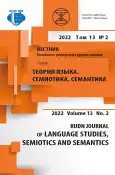Constructed Languages as Semantic and Semiotic Systems
- 作者: Novikov P.N.1
-
隶属关系:
- Peoples’ Friendship University of Russia (RUDN University)
- 期: 卷 13, 编号 2 (2022)
- 页面: 455-467
- 栏目: COGNITIVE RESEARCH
- URL: https://journal-vniispk.ru/2313-2299/article/view/323507
- DOI: https://doi.org/10.22363/2313-2299-2022-13-2-455-467
- ID: 323507
如何引用文章
全文:
详细
The research aims to explore constructed languages as semantic and semiotic systems by analyzing various types of languages based on their lexical, syntactic, morphological and other features. In order to achieve this goal, the author examines the existing classifications of constructed languages and attempts to establish a connection between purposes of their creation and their linguistic features on various levels. The research topic relevance is determined by a substantial rise in popularity of constructed languages, the emergence of their new roles and functions as well as a multitude of new types of media available for communication in these languages and their distribution. The author argues that the recent development in technology provides constructed language creators and enthusiasts with new non-verbal ways of expression that were previously unavailable and thus facilitates communication. This hypothesis is confirmed by several case studies, including the one of “SolReSol: The Project”, an open-source computer program developed by the author, which automates and improves the implementation of semiotic systems designed back in the 19th century. Furthermore, attention is also drawn to the problem of eurocentrism in constructed languages. The research findings lead to the conclusion that on closer inspection both a priori and a posteriori constructed languages created by native speakers of European languages inevitably reveal a certain percentage of Standard Average European features in their semantic and semiotic systems.
作者简介
Philipp Novikov
Peoples’ Friendship University of Russia (RUDN University)
编辑信件的主要联系方式.
Email: philippnovikov@gmail.com
ORCID iD: 0000-0003-4884-3659
PhD. in Philology, Associate Professor, Foreign Language Department, Institute of Law
6, Miklukho-Maklaya str., Moscow, Russian Federation, 117198参考
- Novikov, L.A. (2001). Selected works. Aesthetic aspects of language. Miscellanea. Vol. II. Moscow: Publishing house of RUDN University, 2001. (In Russ.).
- Krasina, E.A., & Vasileva, A.A. (2019). Carthesian Linguistics: two Universal Grammar. In: Language and thinking: psychological and linguistic aspects. Moscow. pp. 28-31. (In Russ.).
- Piperski, A. (2016). Construction of languages: from Esperanto to Dothraki. Moscow: Alpina Publ. (In Russ.).
- Butnaru, N.L. (2016). Means of preserving intentionality and functionality in constructed language translation analyses: a study on Kálmán Kalocsay’s Esperanto poem Somernokto”. Interstudia (Revista Centrului Interdisciplinar de Studiu al. Formelor Discursive Contemporane Interstud), (19), 91-100.
- Punske, J., Sanders, N., & Fountain, A.V. (Eds.). (2020). Language Invention in Linguistics Pedagogy. Oxford: Oxford University Press.
- van Oostendorp, M. (2019). Language contact and constructed languages. In: Handbook of language contact. Boston: De Gruyter Mouton. pp. 124-135. https://doi.org/10.1515/9783110435351-011
- Ng, S.B., & Schwendiman, A. (2017). Properties of Constructed Language Phonological Inventories. Washington: University of Washington, 2.
- Skowrońska, D. (2018). Constructed Languages of Hildegard of Bingen and Suzzette Haden Elgin. Female Empowerment through Language? Forum Filologiczne ATENEUM, 1(6), 101-112 https://doi.org/10.36575/2353-2912/1(6)2018.101 Forum Filologiczne Ateneum 1(6)2018
- Purnomo, S.L.A., Nababan, M., Santosa, R., & Kristina, D. (2017). Ludic linguistics: A revisited taxonomy of fictional constructed language design approach for video games. GEMA Online Journal of Language Studies, 17(4), 45-60.
- Gobbo, F. (2017). Are planned languages less complex than natural languages? Language Sciences, 60, 36-52.
- Gonzalez-Rodriguez, D., & Hernandez-Carrion, J.R. (2018). Self-Organized Linguistic Systems: From traditional AI to bottom-up generative processes. Futures, 103, 27-34.
- van Olmen, D. & van Der Auwera, J. (2016). Modality and mood in Standard Average European. The Oxford handbook of modality and mood, 363-384. https://doi.org/10.1093/oxfordhb/9780199591435.001.0001
- Blahuš, M. (2011). Toki pona-eine minimalistische Plansprache. Spracherfindung und ihre Ziele. Beiträge der, 20, 51-56.
补充文件









